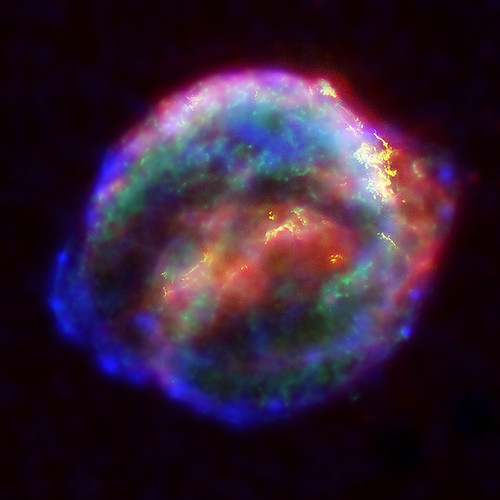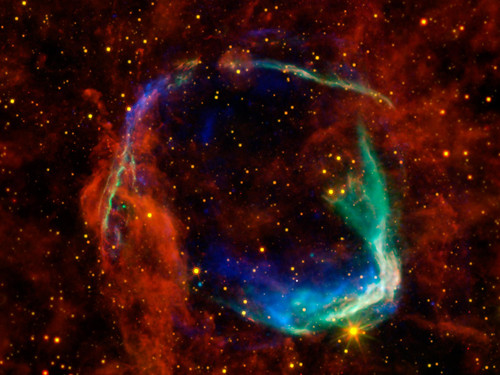A Look into the Building Blocks of Life
- By Brian Williams
- February 22, 2013
- 1 Comment
Maggie’s note: Please welcome a new guest blogger, astronomer Brian Williams!
Most of the stars in the universe will, like our Sun, live steadily for billions of years before ending in relative serenity. However, a select few will go out in a blaze of glory called a supernova, the explosion of an entire star. These cosmic blasts are among the most powerful events in the universe, and can be seen at distances of billions of light years; releasing, in a matter of seconds, an amount of energy equal to the Sun’s output over billions of years. In the past few decades, observations of distant supernovas helped astronomers pin down the expansion rate of the universe, allowing the determination that the universe is not, as was previously expected, slowing down in its expansion, but speeding up, due to the presence of a mysterious force known as “dark energy.”
Nearly all of the matter in the universe that we understand is made of hydrogen and helium, the simplest elements, created in the Big Bang. The rest, including the oxygen that we breath, the carbon, calcium, and iron in our bodies, sodium and choride on our dinner tables, and the silicon in our computer chips were forged in the cores of stars: hot and powerful element factories that convert lighter elements into heavier ones. The gravity that holds stars together generally keeps these elements locked deep inside their interiors, never to be spread throughout the universe. Luckily, supernova explosions provide a mechanism to do just this, liberating these fundamental building blocks of planetary systems and, indeed, life itself, throughout the universe. It is no exaggeration to say that we owe our entire existence to the life, and death, of stars that existed before our Sun and solar system were even created.
In my research at NASA’s Goddard Space Flight Center, the fading of a supernova from view marks only the beginning of my interests. I study the fiery aftermath of the explosion, which remains visible for thousands of years. An exploding star doesn’t simply dissipate into nothingness; rather, it forms a nebula known as a supernova remnant, a cloud of gas expanding at speeds of several million miles per hour. The gas cloud is made up of both material that has been ejected from the now exploded star and particles of gas and dust tenuously floating in the interstellar medium, the scientific name for the space between the stars. An example of a supernova remnant is shown below. This remnant, the remains of a star that exploded in 1604 A.D, is known as Kepler’s SNR, named for the famous German astronomer who kept detailed records of “De Stella Nova” (the New Star).

Kepler’s Supernova remnant, as seen by NASA’s Spitzer Space Telescope (red), Hubble Space Telescope (yellow), and Chandra X-ray Observatory (green and blue). Credit: NASA, R. Sankrit (NASA Ames) and W.P. Blair (Johns Hopkins Univ.)
My work is done primarily in one of two energy regimes: X-rays and infrared. By using NASA telescopes such as the Chandra X-ray Observatory and the Spitzer Space Telescope, we can obtain a multi-wavelength view of these objects. Much of the light we see from supernova remnants comes in the form of X-ray radiation: light produced by extraordinarily hot plasma, heated to millions of degrees by the blast wave of the explosion. By studying the spectrum of this radiation, we can actually see signatures of the various forms of matter (iron, silicon, and oxygen, to name a few) that are spread throughout the galaxy in the explosion. In the infrared, we see light emitted by interstellar dust grains, microscopic solids in the Galaxy that are the precursors to planet and solar system formation. By studying the amount and composition of dust in the Galaxy, we can learn a great deal about how it is created and whether it can survive being encountered by the blast wave from a supernova. Despite only exploding 400 years ago, Kepler’s SNR has already distributed its life-creating elements over several hundred cubic light years and several dozen star systems, providing the seeds for future generations of stars, planets, and perhaps even civilizations to form.
Another example of a supernova remnant is shown below. RCW 86, the remnant of the oldest “recorded” supernova (“recorded” means documented by human observers with surviving records to this day), is all that is left of the supernova of 185 A.D. In 2011, my colleagues and I used X-ray, optical, and infrared images to show that this supernova is the result of a special type of supernova that had previously only been hypothesized. A small star known as a “white dwarf” was contained within a binary star, partnered with a larger companion star. The white dwarf accreted matter from this companion at such a high rate that it blew a powerful “wind” before exploding, excavating a large cavity surrounding the star. When it exploded, the expansion proceeded uninhibited through this cavity for over a millennium, allowing it to expand to a very large size in a small amount of time. In just under 2000 years, this remnant has grown to encompass thousands of star systems, and today reminds us of the importance of studying the universe to understand our own origins and place in the cosmos. The technological enhancements in sensitivity and resolution on future observatories, such as the James Webb Space Telescope, being constructed here at Goddard, will greatly add to our view of objects like supernova remnants by offering us a much deeper and more detailed look into the building blocks of life.

RCW 86, the remains of the supernova of 185 A.D., as seen by NASA’s Spitzer and WISE Telescopes (red and orange), as well as NASA’s Chandra X-ray Observatory and the European Space Agency’s XMM-Newton Observatory (blue and green). Credit: NASA; B. Williams (NASA GSFC)



Fascinating! Inspiring and humbling to think we are made out of star dust.